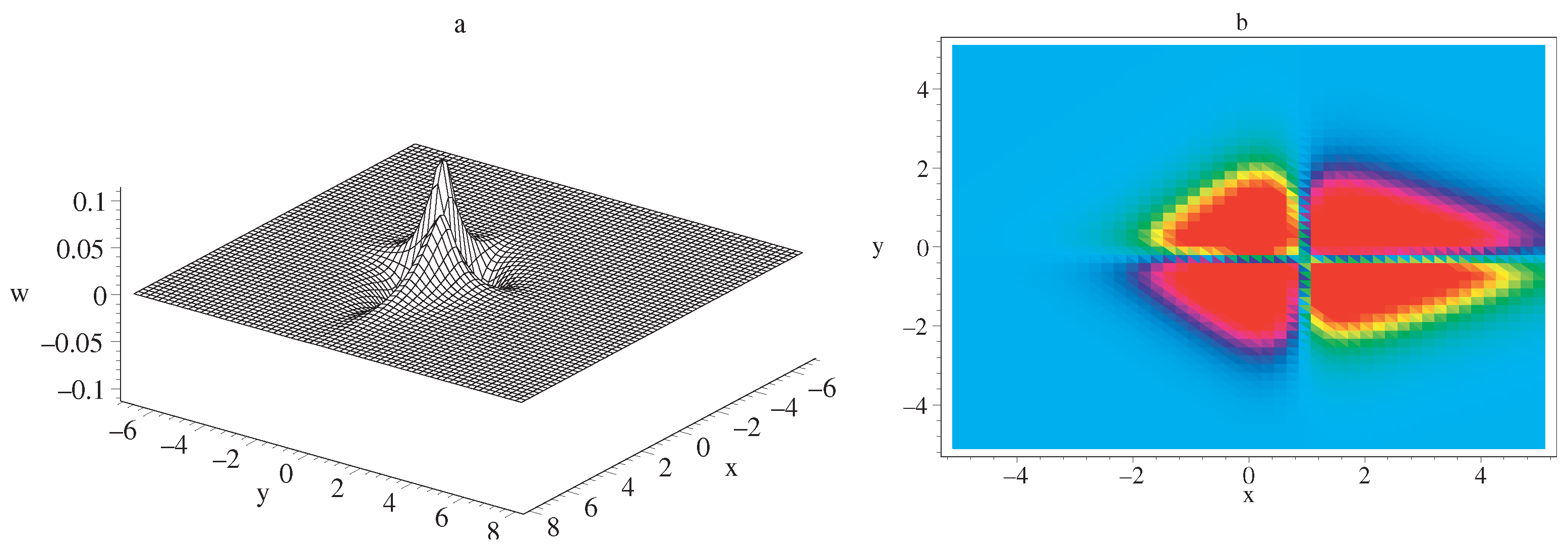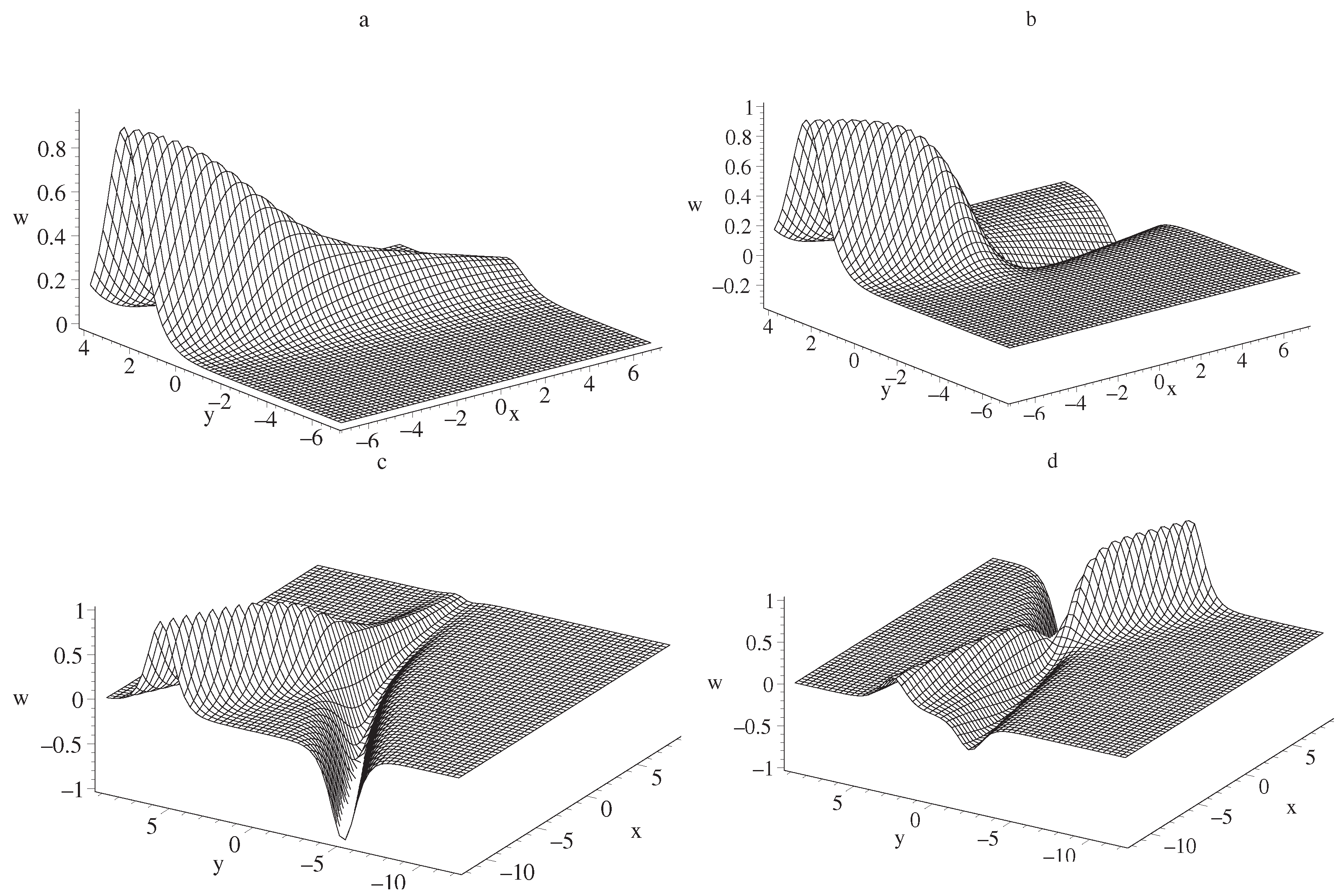Some Novel Fusion and Fission Phenomena for an Extended (2+1)-Dimensional Shallow Water Wave Equation
Abstract
1. Introduction
2. Materials and Methods
3. Results and Discussion
3.1. Special Localized Solutions of SWW Equation
3.2. Special Fission and Fusion Phenomena of SWW Equation
4. Conclusions
Author Contributions
Funding
Institutional Review Board Statement
Informed Consent Statement
Data Availability Statement
Conflicts of Interest
References
- Ablowitz, M.J.; Clarkson, P.A. Soliton, Nonlinear Evolution Equations and Inverse Scattering; Cambridge University Press: Cambridge, UK, 1999. [Google Scholar]
- Jin, X.W.; Lin, J. Rogue wave, interaction solutions to the KMM system. J. Magn. Magn. Mater. 2020, 502, 166590. [Google Scholar] [CrossRef]
- Jin, X.W.; Shen, S.J.; Yang, Z.Y.; Lin, J. Magnetic lump motion in saturated ferromagnetic films. Phys. Rev. E 2022, 105, 014205. [Google Scholar] [CrossRef] [PubMed]
- Zhang, Z.; Yang, X.Y.; Li, B. Soliton molecules and novel smooth positons for the complex modified KdV equation. Appl. Math. Lett. 2020, 103, 106168. [Google Scholar] [CrossRef]
- Zhu, J.Y.; Chen, Y. Data-driven solutions and parameter discovery of the nonlocal mKdV equation via deep learning method. Nonlinear Dyn. 2023, 111, 8397–8417. [Google Scholar] [CrossRef]
- Fang, Y.; Wu, G.Z.; Wang, Y.Y.; Dai, C.Q. Data-driven femtosecond optical soliton excitations and parameters discovery of the high-order NLSE using the PINN. Nonlinear Dyn. 2021, 603–616, 105. [Google Scholar] [CrossRef]
- Ren, B.; Cheng, X.P.; Lin, J. The (2+1)-dimensional Konopelchenko-Dubrovsky equation: Nonlocal symmetries and interaction solutions. Nonlinear Dyn. 2016, 86, 1855–1862. [Google Scholar] [CrossRef]
- Yang, J.J.; Tian, S.F.; Li, Z.Q. Riemann-Hilbert problem for the focusing nonlinear Schrödinger equation with multiple high-order poles under nonzero boundary conditions. Physica D 2022, 432, 133162. [Google Scholar] [CrossRef]
- Li, Y.; Tian, S.F.; Yang, J.J. Riemann-Hilbert problem and interactions of solitons in the n-component nonlinear Schrödinger equations. Stud. Appl. Math. 2022, 148, 577–605. [Google Scholar] [CrossRef]
- Ma, W.X.; Seoud, E.Y.A.E.; Ali, M.R.; Sadat, R. Dynamical behavior and wave speed perturbations in the (2+1) pKP equation. Qual. Theor. Dyn. Syst. 2023, 22, 2–16. [Google Scholar] [CrossRef]
- Hirota, R. The Direct Method in Soliton Theory; Cambridge University Press: Cambridge, UK, 2004. [Google Scholar]
- Lou, S.Y.; Lu, J.Z. Special solutions from variable separation approach: Davey-Stewartson equation. J. Phys. A Math. Gen. 1996, 29, 4029–4215. [Google Scholar] [CrossRef]
- Tang, X.Y.; Lou, S.Y.; Zhang, Y. Localized excitations in (2+1)-dimensional systems. Phys. Rev. E 2002, 66, 046601. [Google Scholar] [CrossRef]
- Shen, S.F. (1+1)-dimensional coupled integrable dispersion-less system. Commun. Theor. Phys. 2005, 44, 779–782. [Google Scholar] [CrossRef]
- Zhang, R.; Shen, S.F. A new exact solution and corresponding localized excitations of the (2+1)-dimensional mKdV equation. Phys. Lett. A 2007, 370, 471–476. [Google Scholar] [CrossRef]
- Zheng, C.L.; Fang, J.P.; Chen, L.Q. New variable separation excitations of a (2+1)-dimensional Broer-Kaup-Kupershmidt system obtained by an extended mapping approach. Z. Naturforsch. A 2004, 59, 912–918. [Google Scholar] [CrossRef]
- Dai, C.Q.; Zhou, G.Q. Exotic interactions between solitons of the (2+1)-dimensional asymmetric Nizhnik-Novikov-Veselov system. Chin. Phys. 2007, 16, 1201–1208. [Google Scholar]
- Dai, C.Q.; Zhou, G.Q.; Zhang, J.F. Exotic localized structures based on variable separation solution of (2+1)-dimensional KdV equation via the extended tanh-function method. Chaos Soliton Fract. 2007, 33, 1458–1467. [Google Scholar] [CrossRef]
- Dai, C.Q.; Zhang, J.F. Variable separation solutions for the (2+1)-dimensional generalized Nizhnik-Novikov-Veselov equation. Chaos Soliton Fract. 2007, 33, 564–571. [Google Scholar] [CrossRef]
- Dai, C.Q.; Wang, Y.Y. Localized coherent structures based on variable separation solution of the (2+1)-dimensional Boiti-Leon-Pempinelli equation. Nonlinear Dyn. 2012, 70, 189–196. [Google Scholar] [CrossRef]
- Dai, C.Q.; Chen, R.P. Solitons with fusion and fission properties in the (2+1)-dimensional modified dispersive water wave system. Z. Naturforsch. 2006, 61, 307–315. [Google Scholar] [CrossRef]
- Dai, C.Q.; Zhang, J.F. New types of interactions based on variable separation solutions via the general projective Riccati equation method. Rev. Math. Phys. 2007, 19, 195–226. [Google Scholar] [CrossRef]
- Dai, C.Q. Semifoldons with fusion and fission properties of (2+1)-dimensional nonlinear system. Chaos Soliton Fract. 2008, 38, 474–480. [Google Scholar] [CrossRef]
- Quan, J.F.; Tang, X.Y. New variable separation solutions and localized waves for (2+1)-dimensional nonlinear systems by a full variable separation approach. Phys. Scr. 2023, 98, 125269. [Google Scholar] [CrossRef]
- Dong, H.H.; Zhang, Y.F. Exact periodic wave solution of extended (2+1)-dimensional shallow water wave equation with generalized -operators. Commun. Theor. Phys. 2015, 63, 401–405. [Google Scholar] [CrossRef]
- Roshid, H.O.; Ma, W.X. Dynamics of mixed lump-solitary waves of an extended (2+1)-dimensional shallow water wave model. Phys. Lett. A 2018, 382, 3262–3268. [Google Scholar] [CrossRef]
- He, L.C.; Zhang, J.W.; Zhao, Z.L. M-lump and interaction solutions of a (2+1)-dimensional extended shallow water wave equation. Eur. Phys. J. Plus 2021, 136, 192. [Google Scholar] [CrossRef]
- Alsufi, N.A.; Fatima, N.; Noor, A.; Gorji, M.R.; Alam, M.M. Lumps and interactions, fission and fusion phenomena in multi solitons of extended shallow water wave equation of (2+1)-dimensions. Chaos Soliton Fract. 2023, 170, 113410. [Google Scholar] [CrossRef]
- Ma, W.X.; Zhou, Y. Lump solutions to nonlinear partial differential equations via Hirota bilinear forms. J. Differ. Equ. 2018, 264, 2633–2659. [Google Scholar] [CrossRef]
- Ma, W.X. Lump solutions to the Kadomtsev-Petviashvili equation. Phys. Lett. A 2015, 379, 1975–1978. [Google Scholar] [CrossRef]
- Stegeman, G.I.; Segev, M. Optical spatial solitons and their interactions: Universality and diversity. Science 1999, 286, 1518–1523. [Google Scholar] [CrossRef]
- Kartashov, Y.V.; Malomed, B.A.; Torner, L. Solitons in nonlinear lattices. Rev. Mod. Phys. 2011, 83, 247. [Google Scholar] [CrossRef]
- Cui, C.J.; Tang, X.Y.; Cui, Y.J. New variable separation solutions and wave interactions for the (3+1)-dimensional Boiti-Leon-Manna-Pempinelli equation. Appl. Math. Lett. 2020, 102, 106109. [Google Scholar] [CrossRef]
- Tang, X.Y.; Cui, C.J.; Liang, Z.F.; Ding, W. Novel soliton molecules and wave interactions for a (3+1)-dimensional nonlinear evolution equation. Nonlinear Dyn. 2021, 105, 2549–2557. [Google Scholar] [CrossRef]
- Shao, C.; Yang, L.; Yan, Y.; Wu, J.; Zhu, M.; Li, L. Periodic, n-soliton and variable separation solutions for an extended (3+1)-dimensional KP-Boussinesq equation. Sci. Rep. 2023, 13, 15826. [Google Scholar] [CrossRef] [PubMed]









Disclaimer/Publisher’s Note: The statements, opinions and data contained in all publications are solely those of the individual author(s) and contributor(s) and not of MDPI and/or the editor(s). MDPI and/or the editor(s) disclaim responsibility for any injury to people or property resulting from any ideas, methods, instructions or products referred to in the content. |
© 2024 by the authors. Licensee MDPI, Basel, Switzerland. This article is an open access article distributed under the terms and conditions of the Creative Commons Attribution (CC BY) license (https://creativecommons.org/licenses/by/4.0/).
Share and Cite
Zhou, K.; Zhu, J.-R.; Ren, B. Some Novel Fusion and Fission Phenomena for an Extended (2+1)-Dimensional Shallow Water Wave Equation. Symmetry 2024, 16, 82. https://doi.org/10.3390/sym16010082
Zhou K, Zhu J-R, Ren B. Some Novel Fusion and Fission Phenomena for an Extended (2+1)-Dimensional Shallow Water Wave Equation. Symmetry. 2024; 16(1):82. https://doi.org/10.3390/sym16010082
Chicago/Turabian StyleZhou, Kai, Jia-Rong Zhu, and Bo Ren. 2024. "Some Novel Fusion and Fission Phenomena for an Extended (2+1)-Dimensional Shallow Water Wave Equation" Symmetry 16, no. 1: 82. https://doi.org/10.3390/sym16010082
APA StyleZhou, K., Zhu, J.-R., & Ren, B. (2024). Some Novel Fusion and Fission Phenomena for an Extended (2+1)-Dimensional Shallow Water Wave Equation. Symmetry, 16(1), 82. https://doi.org/10.3390/sym16010082






